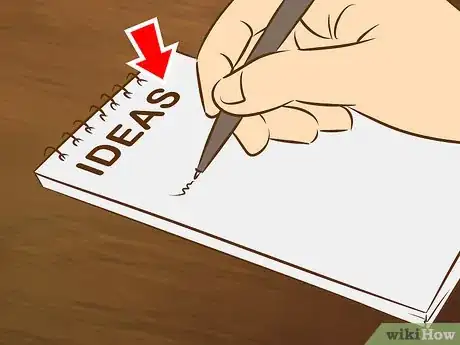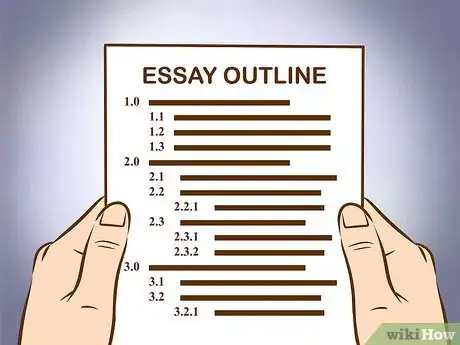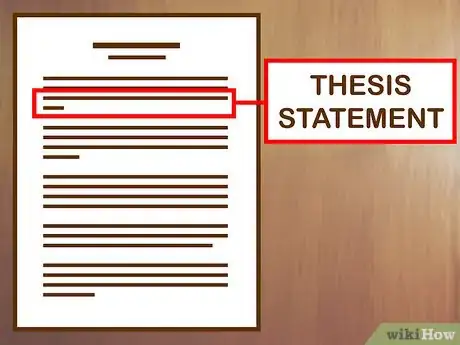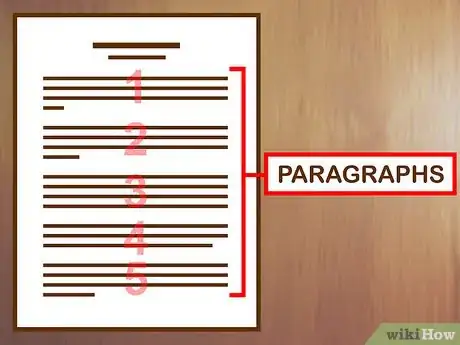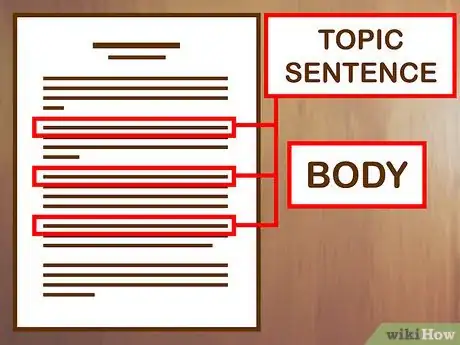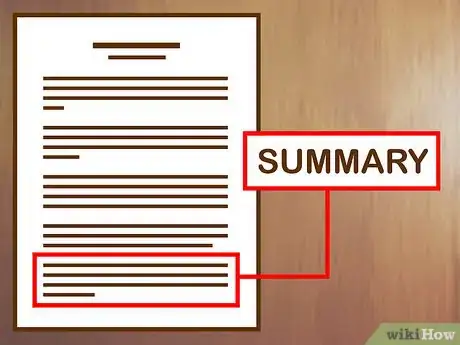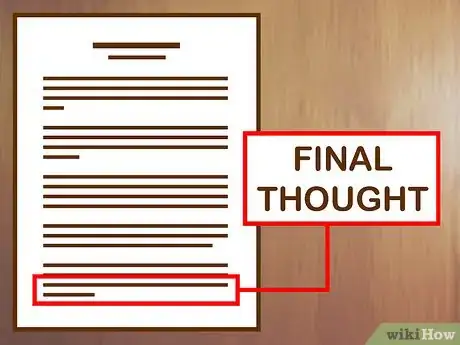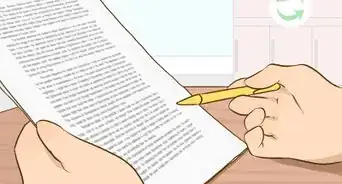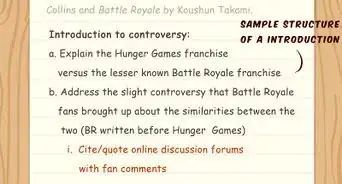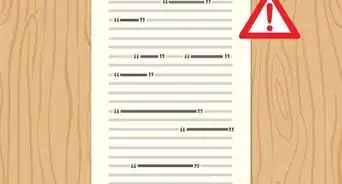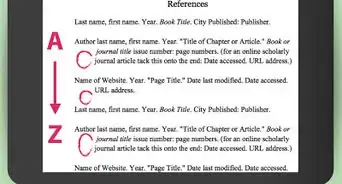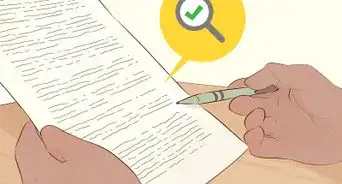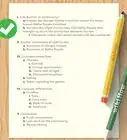This article was co-authored by Tristen Bonacci. Tristen Bonacci is a Licensed English Teacher with more than 20 years of experience. Tristen has taught in both the United States and overseas. She specializes in teaching in a secondary education environment and sharing wisdom with others, no matter the environment. Tristen holds a BA in English Literature from The University of Colorado and an MEd from The University of Phoenix.
There are 10 references cited in this article, which can be found at the bottom of the page.
wikiHow marks an article as reader-approved once it receives enough positive feedback. In this case, 84% of readers who voted found the article helpful, earning it our reader-approved status.
This article has been viewed 556,908 times.
Expository essays are often assigned in academic settings. In an expository essay, you need to consider an idea, investigate the idea, then explain the idea. Some expository essays may include an argument, while others are purely informative.[1] While it may seem overwhelming, writing an expository essay is easy if you take it one step at a time.
Steps
Sample Essay Conclusion
Planning Your Essay
-
1Define your purpose for writing. Think about why you are writing an expository essay. Jot down some of the reasons why you are writing an expository essay and what you hope to do with your completed essay.[2]
- If you are writing an expository essay for an assignment, read the assignment guidelines. Ask your instructor if anything seems unclear.
-
2Consider your audience. Think about who will be reading your expository essay. Consider the needs and expectations of your readers before your begin writing.[3] Jot down some of the things that you will need to keep in mind about your readers as you write your expository essay.[4]
- If you are writing your essay for a class assignment, consider what your instructor will expect you to include in your essay.
Advertisement -
3Generate ideas for your expository essay. Before you begin writing your essay, you should take some time to flesh out your ideas and get some things down on paper. Invention activities like listing, freewriting, clustering, and questioning can help you to develop ideas for your expository essay.[5]
- Try listing. List all your ideas for your expository essay. Then look over the list you have made and group similar ideas together. Expand those lists by adding more ideas or by using another prewriting activity.[6]
- Try freewriting. Write nonstop for about 10 minutes. Write whatever comes to mind and don’t edit yourself. After you finish writing, review what you have written. Highlight or underline the most useful information for your expository essay. Repeat the freewriting exercise using the passages you underlined as a starting point. You can repeat this exercise many times to continue to refine and develop your ideas. [7]
- Try clustering. Write a brief explanation of the subject of your expository essay on the center of a piece of paper and circle it. Then draw three or more lines extending from the circle. Write a corresponding idea at the end of each of these lines. Continue developing your cluster until you have explored as many connections as you can.[8]
- Try questioning. On a piece of paper, write out “Who? What? When? Where? Why? How?” Space the questions about two or three lines apart on the paper so that you can write your answers on these lines. Respond to each question in as much detail as you can.[9]
-
4Make an outline. Once you have gotten some of your ideas on paper, you may want to organize those ideas into an outline before you begin drafting your essay. You can draft an outline to plan out your whole essay, develop more ideas, and figure out if you have forgotten anything.[10]
-
5Find appropriate sources. See your assignment guidelines or ask your instructor if you have questions about what types of sources are appropriate for this assignment. Books, articles from scholarly journals, magazine articles, newspaper articles, and trustworthy websites are some sources that you might consider using.[11]
- Trustworthy internet sources usually include academic institutions like universities or research labs, government websites, and non-profit organizations.
-
6Evaluate your sources to determine their credibility before you decide to use them. There are several things that you will need to consider in order to determine whether or not a source is trustworthy.[12]
- Identify the author and his or her credentials. Think about what qualifies this person to write about their subject. If the source has no author or the author does not have adequate credentials, then this source may not be trustworthy.
- Check for citations to see if this author has researched the topic well enough. If the author has provided few or no sources, then this source may not be trustworthy.
- Look for bias. Think about whether or not this author has presented an objective, well-reasoned account of the topic. If the author seems to value a particular argument or slant that is not supported or only thinly supported by fact, then this source may not be trustworthy.
- Consider the publication date to see if this source presents the most up to date information on the subject.
- Cross-check some of the information in the source. If you are still concerned about a source, cross-check some of its information against a trustworthy source.
-
7Read your sources well. Make sure that you understand what the author is saying. Take time to look up words and concepts that you do not understand. Otherwise, you might end up misreading and misusing your sources.[13]
-
8Take notes while you read your sources. Highlight and underline significant passages so that you can come back to them. As you read, take note of significant information in your sources by jotting the information down in a notebook.[14]
- Show when you have quoted a source word for word by putting it into quotation marks. Include information about the source such as the author’s name, article title or book title, and page number.
- Write down the publishing information of each source. You will need this information for your "References," "Bibliography," or "Works Cited" pages. Format this page according to your instructor's guidelines.
-
9Develop your tentative thesis. Effective thesis statements express the main focus of a paper and state an arguable claim. A thesis is often one sentence in length but may be longer depending on your topic and the detail of your essay.[15]
- Make sure your thesis is arguable. Do not state facts or matters of taste. For example, "George Washington was the first president of the United States," is not a good thesis because it states a fact. Likewise, "Die Hard is a great movie," is not a good thesis because it expresses a matter of taste.[16]
- Make sure your thesis provides enough detail. In other words, avoid just saying that something is "good" or "effective." Instead, say what makes something "good" or "effective.[17]
Introducing Your Essay
-
1Begin with an engaging sentence that gets right into your topic. Your introduction should immediately begin discussing your topic. Think about what you will discuss in your essay to help you determine what you should include in your introduction.[18] Keep in mind that your introduction should identify the main idea of your expository essay and act as a preview to your essay.[19]
- An engaging hook can take many forms. You could start with an anecdote, an informative and attention-grabbing quote, a bold opinion statement, or anything that will make your readers want to continue with your essay.
-
2Provide context. Provide enough background information or context to guide your readers through your essay. Think about what your readers will need to know to understand the rest of your essay. Provide this information in your first paragraph.
- If you are writing about a book, provide the name of the work, the author, and a brief summary of the plot.
- If you are writing about a specific day in history, summarize the day's events. Then, explain how it fits into a broader historical scope.
- If you are writing about a person, name the person and provide a brief biography.
- Keep in mind that your context should lead up to your thesis statement. Explain everything your reader needs to know to understand what your topic is about. Then narrow it down until you reach the topic itself.
-
3Provide your thesis statement. Your thesis statement should be 1-2 sentences that express your main argument. If your essay is purely informative, it should address your methods for presenting your information to your readers.[20]
Expressing Your Main Points
-
1Determine how many paragraphs to include. The most common length for an expository essay is five-paragraphs, but an expository essay can be longer than that. Refer to your assignment guidelines or ask your instructor if you are unsure about the required length of your paper.
- A five-paragraph essay should include three body paragraphs. Each body paragraph should discuss a piece of supporting evidence that supports your thesis.
- Even if your essay is longer than five paragraphs, the same principles still apply. Each paragraph should discuss a piece of supporting evidence.
-
2Begin each paragraph with a topic sentence. The topic sentence introduces the main idea of the paragraph. It should introduce one piece of supporting evidence that supports your thesis. If you're working with a specific text, you may start with a direct quote or a properly cited paraphrase of the argument you're referencing.
- For example, if you are writing an expository essay about the use of dogs in the US Marine Corps during WWII, your main ideas and topic sentences could be something like:
- "Dogs played an active role in Marine Corps missions in the Pacific."
- "The Doberman Pinscher was the official dog of the US Marine Corps during WWII, but all breeds were eligible to train as war dogs."
- "War dogs were even eligible to receive military awards for their service."
- For example, if you are writing an expository essay about the use of dogs in the US Marine Corps during WWII, your main ideas and topic sentences could be something like:
-
3Elaborate on your supporting evidence. After you have stated your topic sentence, provide specific evidence from your research to support it. Offer a new piece of evidence for every body paragraph in your essay.
- Most of your evidence should be in the form of cited quotes, paraphrases, and summaries from your research.
- Your evidence could also come from interviews, anecdotes, or personal experience.
- Try to provide at least two to three pieces of evidence to support each of your claims.
- For example, if a paragraph starts with, "War dogs were even eligible to receive military awards for their service," the supporting evidence might be a list of dogs who got awards and the awards they were given.
-
4Analyze the significance of each piece of evidence. Explain how the evidence you have provided in that paragraph connects to your thesis. Write a sentence or two for each piece of evidence. Consider what your readers will need to know as you explain these connections.
-
5Conclude and transition into your next paragraph. Each paragraph should transition into the next. The conclusion of each body paragraph should sum up your main point while showing how it works with your next point.
- For example, imagine that you want to connect two paragraphs that begin with these sentences: "The Doberman Pinscher was the official dog of the US Marine Corps during WWII, but all breeds could train as war dogs." And, "War dogs were, in fact, eligible to receive military awards for their service." Your concluding sentence would need to combine the idea of dog breeds with the idea of dogs receiving military awards.
- You could write, "Even though Dobermans were the most common breed used in WWII, they were not the only breed, and were not the only dogs recognized for their help."
- For example, imagine that you want to connect two paragraphs that begin with these sentences: "The Doberman Pinscher was the official dog of the US Marine Corps during WWII, but all breeds could train as war dogs." And, "War dogs were, in fact, eligible to receive military awards for their service." Your concluding sentence would need to combine the idea of dog breeds with the idea of dogs receiving military awards.
Concluding Your Essay
-
1Restate and rephrase your thesis. The first sentence of your concluding paragraph should restate your thesis. But you should not just restate your thesis. You should also say what the evidence you have provided has added to your thesis.[21]
- For example, if your original thesis was, "Dogs used by the United States Marine Corps during WWII played a significant role in the Pacific theater,” then your restated thesis might be something like, “Dogs of all breeds and sizes had an important and honored role to play in WWII, especially in the Pacific theater.”
- Note that the second sentence repeats the information provided in your original thesis. It just says it in a new way while also hinting at the information you included in the body of the essay.
- For example, if your original thesis was, "Dogs used by the United States Marine Corps during WWII played a significant role in the Pacific theater,” then your restated thesis might be something like, “Dogs of all breeds and sizes had an important and honored role to play in WWII, especially in the Pacific theater.”
-
2Summarize and review your main ideas. Take one sentence to summarize each main piece of supporting evidence, as presented in your essay's body.[22] You should not introduce any new information in your conclusion. Revisit your most compelling claims and discuss how they all support your main point.[23]
-
3Offer a final thought or call to action. Use your last sentence to make a final statement about your topic. This last part of your final paragraph is your opportunity to say what should happen next. You can offer a solution or ask a new question about your topic.[24]
- Explain how the topic affects the reader
- Explain how your narrow topic applies to a broader theme or observation
- Call the reader to action or further exploration on the topic
- Present new questions that your essay introduced
Expert Q&A
-
QuestionWhat is an example of an expository essay?
 Tristen BonacciTristen Bonacci is a Licensed English Teacher with more than 20 years of experience. Tristen has taught in both the United States and overseas. She specializes in teaching in a secondary education environment and sharing wisdom with others, no matter the environment. Tristen holds a BA in English Literature from The University of Colorado and an MEd from The University of Phoenix.
Tristen BonacciTristen Bonacci is a Licensed English Teacher with more than 20 years of experience. Tristen has taught in both the United States and overseas. She specializes in teaching in a secondary education environment and sharing wisdom with others, no matter the environment. Tristen holds a BA in English Literature from The University of Colorado and an MEd from The University of Phoenix.
Licensed English Teacher An example of an expository essay could be discussing how to ride a particular type of bike. You'd take the reader through those steps so they could paint a clear picture in their head.
An example of an expository essay could be discussing how to ride a particular type of bike. You'd take the reader through those steps so they could paint a clear picture in their head. -
QuestionHow can I start the introduction?
 Community AnswerWith a sentence that catches the readers attention, also known as a “hook”. This can be a question, fact, joke or an outrageous claim.
Community AnswerWith a sentence that catches the readers attention, also known as a “hook”. This can be a question, fact, joke or an outrageous claim.
References
- ↑ https://owl.purdue.edu/owl/general_writing/academic_writing/essay_writing/expository_essays.html
- ↑ https://www.grammarly.com/blog/expository-essay/
- ↑ Tristen Bonacci. Licensed English Teacher. Expert Interview. 21 December 2021.
- ↑ https://owl.purdue.edu/owl/general_writing/academic_writing/essay_writing/expository_essays.html
- ↑ http://writing.ku.edu/prewriting-strategies
- ↑ http://writing.ku.edu/prewriting-strategies
- ↑ http://writing.ku.edu/prewriting-strategies
- ↑ http://writing.ku.edu/prewriting-strategies
- ↑ http://writing.ku.edu/prewriting-strategies
- ↑ https://grammar.yourdictionary.com/grammar-rules-and-tips/tips-on-writing-an-excellent-expository-essay.html
- ↑ https://www.grammarly.com/blog/expository-essay/
- ↑ https://owl.purdue.edu/owl/general_writing/academic_writing/essay_writing/expository_essays.html
- ↑ https://www.grammarly.com/blog/expository-essay/
- ↑ http://www.writing.utoronto.ca/advice/reading-and-researching/notes-from-research
- ↑ http://writingcenter.unc.edu/handouts/thesis-statements/
- ↑ http://writingcenter.unc.edu/handouts/thesis-statements/
- ↑ http://writingcenter.unc.edu/handouts/thesis-statements/
- ↑ https://grammar.yourdictionary.com/grammar-rules-and-tips/tips-on-writing-an-excellent-expository-essay.html
- ↑ Tristen Bonacci. Licensed English Teacher. Expert Interview. 21 December 2021.
- ↑ https://grammar.yourdictionary.com/grammar-rules-and-tips/tips-on-writing-an-excellent-expository-essay.html
- ↑ https://writingcenter.unc.edu/tips-and-tools/thesis-statements/
- ↑ Tristen Bonacci. Licensed English Teacher. Expert Interview. 21 December 2021.
- ↑ https://owl.purdue.edu/owl/research_and_citation/using_research/quoting_paraphrasing_and_summarizing/index.html
- ↑ https://owl.purdue.edu/owl/general_writing/common_writing_assignments/argument_papers/conclusions.html
About This Article
Before you write an expository essay, take some time to jot down ideas for your essay. Try the clustering method by writing a brief explanation of your subject in a bubble in the center of your page. Then, draw 3 or more lines extending from the circle and jot down idea bubbles that connect to your main theme. Once you have a plan for your expository essay, write out an outline to organize what you’re going to say. Make sure to begin your outline with an engaging introduction sentence. After the introduction sentence, provide some background information and include your thesis statement, which is your main argument. If you’re writing a 5 paragraph essay, you should include 3 body paragraphs after your introduction then a conclusion paragraph that summarizes your main points. However you organize your essay, make sure to include credible sources for important information, like statistics, so your teacher knows that it’s accurate. To learn how to use transitions in your essay, read more from our Writing co-author.




